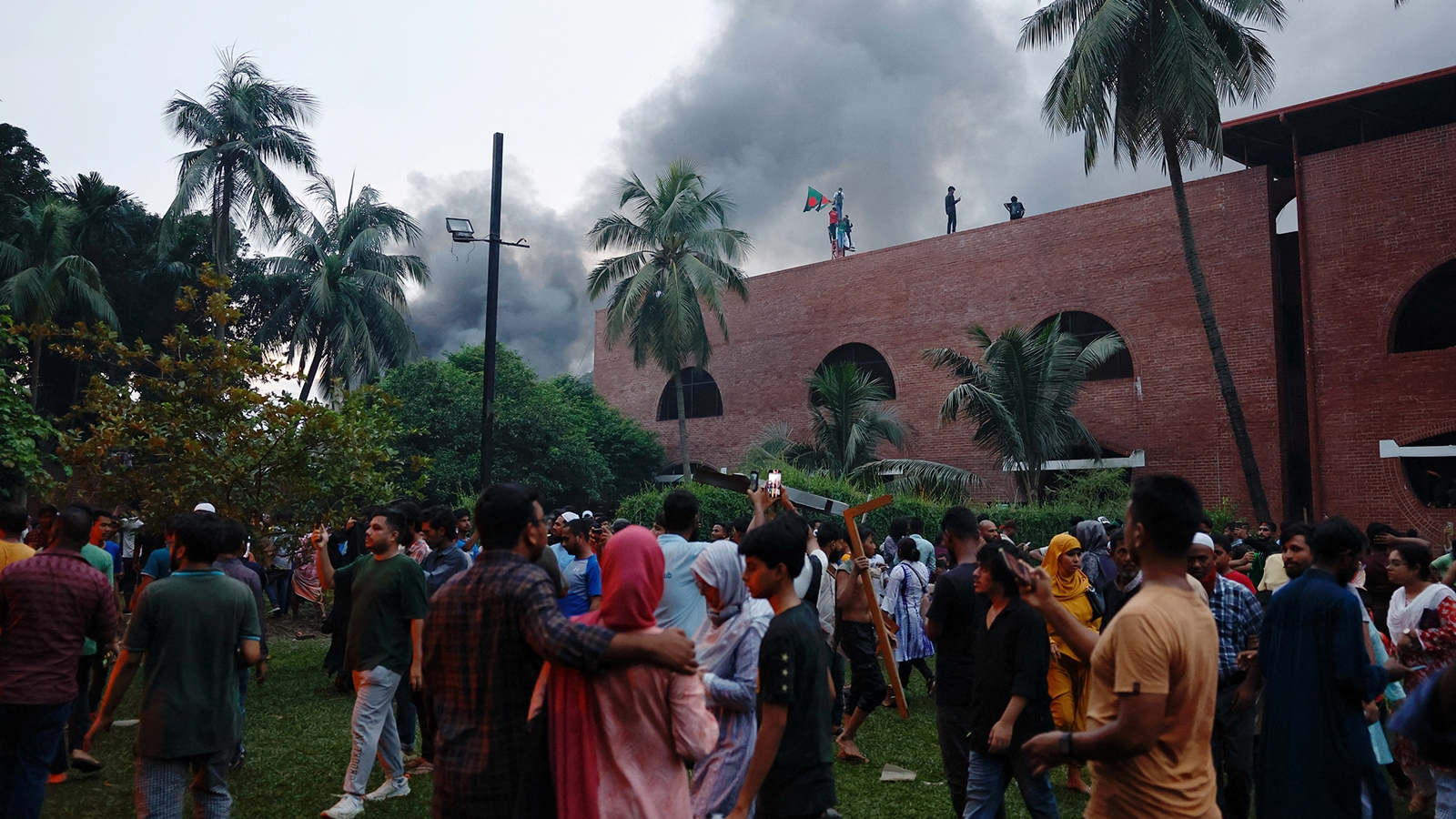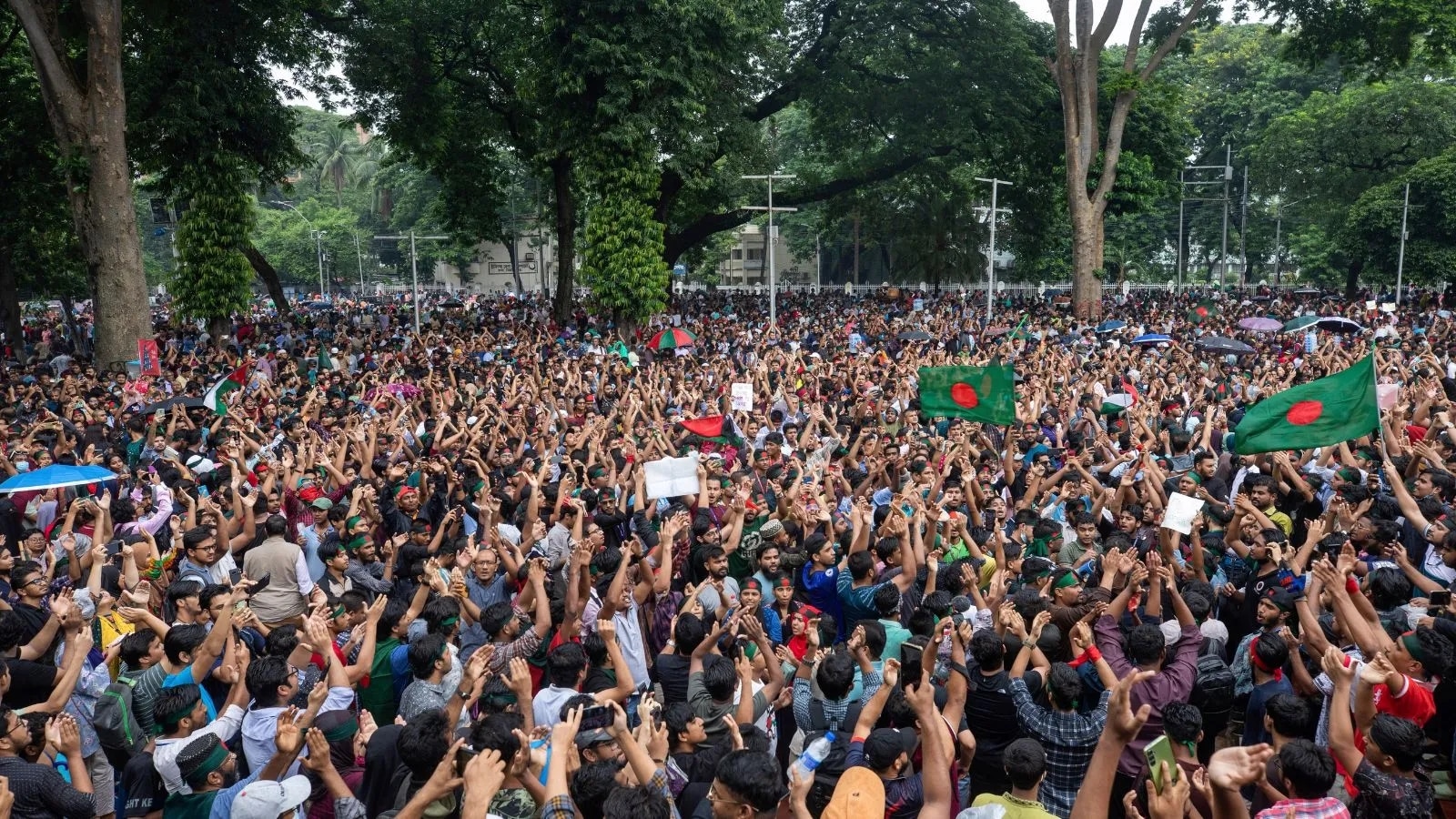In 1975, the sisters had taken refuge in India after soldiers assassinated their father, Sheikh Mujibur Rahman, along with seven members of the family, including Mujib’s 10-year-old son Russell (named after the British philosopher Bertrand Russell). Hasina escaped because she was then in Germany with her husband and Rehana.

Army in politics
The chequered history of Bangladeshi democracy has seen periodic interventions by the military. The army appointed Chief Justice Abu Sadat Mohammad Sayem as president in November 1975, and the country was ruled by a military junta.
In 1977, Gen Ziaur Rahman became president; he was assassinated in 1981 and his successor Abdus Sattar was removed in a coup in 1982. Army chief H M Ershad took control, but mass unrest led to his resignation in 1990.
The civilian governments of Khaleda Zia, widow of Gen Ziaur Rahman (1991-96 and 2001-06), and Sheikh Hasina (1996-2001) followed. In between, there was an attempted coup in 1996.
 Smoke rising from Ganabhaban, the PM’s residence, which was stormed by public shortly after Hasina’s resignation. (Reuters)
Smoke rising from Ganabhaban, the PM’s residence, which was stormed by public shortly after Hasina’s resignation. (Reuters)
Following widespread unrest at the end of Khaleda’s term in 2006, the military asked the then president to declare an emergency. A caretaker government was in charge from January 2007 to December 2008.
After Hasina came back to power in 2008, she made sure that the army returned to the barracks. In 2010, the Supreme Court reduced the scope for military interventions through legal loopholes, and reaffirmed the secular principles of the Bangladesh constitution.
Hasina’s goodwill
Story continues below this ad
Hasina’s regime brought political stability and economic growth to the country. India was one of the beneficiaries of her return, and a benefactor as well.
In 2009, the Manmohan Singh government reached out with humanitarian aid and assistance. It helped that Hasina had deep personal ties with the Gandhi family; Indira Gandhi had played a pivotal role in the liberation of Bangladesh. Hasina’s personal rapport with Sonia Gandhi, as well as Rahul and Priyanka, was evident when she visited India in June.
Former President Pranab Mukherjee acted as Hasina’s local guardian when, in the years after Mujib’s assassination, she lived on Delhi’s Pandara Road. Mukherjee’s wife Suvra is said to have introduced Hasina as her relative. Decades later, Hasina would attend both their funerals.
 Protesters celebrate beside a defaced portrait of Prime Minister Sheikh Hasina after news of her resignation, in Dhaka, Bangladesh. (AP)
Protesters celebrate beside a defaced portrait of Prime Minister Sheikh Hasina after news of her resignation, in Dhaka, Bangladesh. (AP)
These early experiences left an indelible impact on Hasina, and she developed a deep gratitude for the Indian leadership and its people. She received bipartisan support in India — after assuming office in 2014, Prime Minister Narendra Modi also reached out to her. The core concerns of fighting religious extremism and countering terrorism was the strategic glue that bound successive Indian governments with Hasina’s regime.
Story continues below this ad
With this bi-partisan support, the outstanding maritime boundary issue was resolved, followed by the land boundary agreement. As Bangladesh’s economy grew rapidly, India extended it billions of dollars in lines of credit, and supported its infrastructure and humanitarian requirements.
India’s attitude
As Hasina won election after election — in 2013, 2018, and 2024 — she faced questions of legitimacy and alleged rigging, especially from the US and the West. But she could bank on India for full-fledged, no-questions-asked support.
This support was founded on India’s experience during the BNP-Jamaat rule in 2001-06, when anti-India terror groups operated with impunity from Bangladeshi soil. On returning to power, Hasina went after these terror groups and their benefactor, the Jamaat-e-Islami Bangladesh.
She extended her crackdown to the main opposition BNP as well — the war tribunal hanged Jamaat leaders for 1971 war crimes, jailed BNP leader Khaleda Zia for alleged corruption, and jailed hundreds of Opposition leaders and activists. As India looked the other way for its own national security and strategic reasons, Hasina’s crackdown extended to the dissenting voices in civil society and media as well.
Story continues below this ad
 People participate in a protest march against Prime Minister Sheikh Hasina and her government, demanding justice for the victims killed in the recent countrywide deadly clashes, in Dhaka, Bangladesh. (AP)
People participate in a protest march against Prime Minister Sheikh Hasina and her government, demanding justice for the victims killed in the recent countrywide deadly clashes, in Dhaka, Bangladesh. (AP)
As she landed in India on Monday — some say she may be headed to London — National Security Advisor Ajit Doval met her at the Hindon Air Force station. New Delhi will have to work towards ensuring her safety — even as it is likely to face some questions from the new regime in Dhaka about giving refuge to an unpopular leader.
For New Delhi, Hasina will always be the leader who helped make its eastern borders quiet and stable.
The way forward
New Delhi has its diplomatic task cut out going forward. It shunned the BNP and Jamaat for the past decade-and-half, choosing Hasina’s Awami League as its favoured party in Bangladesh. During these years, the Bangladeshi opposition viewed India as backing Hasina, and the West as being on their side.
There is a real risk of blowback from the Bangladeshi people as well. What attitude the new power centres in Dhaka — some of whom will carry past grudges — take towards India will be critical.
Story continues below this ad
The challenges encountered during the earlier BNP-Jamaat years could well resurface. New Delhi cannot afford to have another front open when the LoC and the border with Pakistan is hot again, and the Indian Army is in a long standoff with the PLA in eastern Ladakh. The Myanmar border remains extremely volatile, and the source of unrest in India’s Northeast.
The army chief will play an important role. New Delhi has had robust links with the Bangladeshi security establishment due to the common threats from terrorism and extremism. Those ties might come in handy now, as “anti-India elements” take charge.



 Smoke rising from Ganabhaban, the PM’s residence, which was stormed by public shortly after Hasina’s resignation. (Reuters)
Smoke rising from Ganabhaban, the PM’s residence, which was stormed by public shortly after Hasina’s resignation. (Reuters) Protesters celebrate beside a defaced portrait of Prime Minister Sheikh Hasina after news of her resignation, in Dhaka, Bangladesh. (AP)
Protesters celebrate beside a defaced portrait of Prime Minister Sheikh Hasina after news of her resignation, in Dhaka, Bangladesh. (AP) People participate in a protest march against Prime Minister Sheikh Hasina and her government, demanding justice for the victims killed in the recent countrywide deadly clashes, in Dhaka, Bangladesh. (AP)
People participate in a protest march against Prime Minister Sheikh Hasina and her government, demanding justice for the victims killed in the recent countrywide deadly clashes, in Dhaka, Bangladesh. (AP)




































